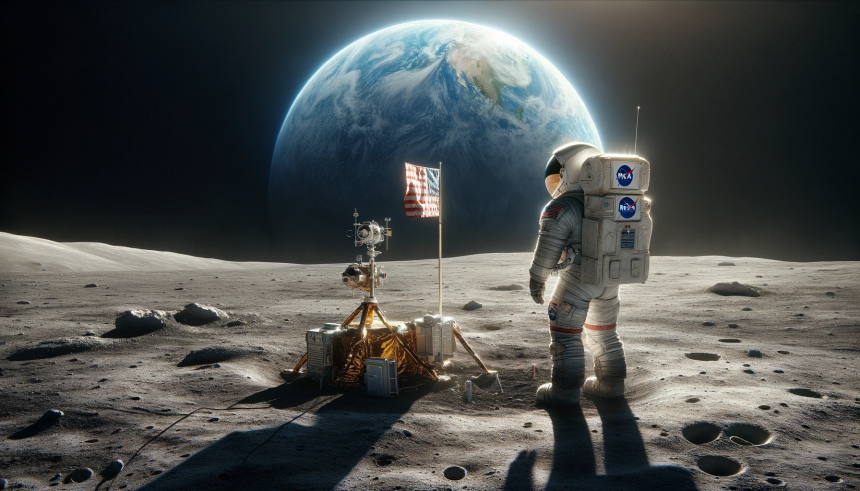In an effort to prepare for the Artemis III mission, NASA astronauts Kate Rubins and Andre Douglas conducted four moonwalk simulations in Arizona’s San Francisco Volcanic Field. This location was chosen due to its geological resemblance to the Moon’s South Pole. The simulations were designed to test spacesuits, tools, and technology, while also allowing flight controllers and scientists to practice their roles. NASA’s extensive simulations are critical for addressing potential issues and ensuring astronaut safety.
Practice to Prepare
Rubins and Douglas, along with a team of engineers and scientists, participated in a series of moonwalks between May 13 and May 22, 2024. They navigated through the volcanic terrain, making geological observations and collecting samples. This exercise also included testing a heads-up display using augmented reality for navigation and lighting beacons to guide astronauts back to the lunar lander. These simulations are essential for refining the tools and procedures for the upcoming Artemis III mission.
During these simulations, the astronauts wore backpacks equipped with lighting, communication, and power devices. They practiced identifying subtle differences in rock formations, which will be crucial for understanding the Moon’s geological history. The site’s resemblance to the lunar South Pole provides a realistic environment for these tests, although unexpected challenges like strong winds required adjustments.
Science at the Table
NASA’s Johnson Space Center scientists monitored the moonwalks from a mock mission control center, using live video and audio feeds. The team developed detailed plans, coordinated tasks, and evaluated geological data sent by the astronauts. This process helps ensure that the crew’s science tasks are accurately completed and allows for real-time adjustments based on new findings. The collaboration between scientists and flight controllers is vital for the success of the mission.
The Arizona simulations also served as a practical test for geological mapping techniques that will be applied on the Moon. Using Earth satellite data, scientists created maps of the volcanic field, which were then verified by comparing the astronauts’ reported locations to the mapped features. This process is critical for selecting scientifically valuable landing sites on the Moon.
Operating in Moon-Like Conditions
Nighttime simulations were conducted to replicate the lighting conditions of the Moon’s South Pole, where the Sun moves horizontally across the horizon. The astronauts tested supplemental portable lights, significantly improving their visibility. These simulations highlight the challenges of navigating and performing tasks in low-light conditions, emphasizing the need for effective lighting solutions.
The use of custom-designed software for managing moonwalks was another key aspect of the simulations. This software catalogs extensive audio, video, and image data, helping the team plan and track tasks efficiently. Such tools are crucial for maintaining astronaut safety and ensuring that scientific objectives are met during the mission.
The entry of NASA into this new era of lunar exploration builds on the legacy of the Apollo missions. The detailed training and simulations conducted in Arizona are reminiscent of the preparation undertaken for Apollo, emphasizing the importance of geological training for astronauts. The integration of modern technology and techniques ensures that Artemis III astronauts will be well-prepared for their mission.
Reflecting on past lunar missions, the use of detailed planning and practice has always been a cornerstone of NASA’s approach. The Apollo missions saw astronauts undergo rigorous training in various terrains to simulate the Moon’s surface. This historical context underscores the continuous evolution of astronaut training and mission preparation, with each new mission building on the lessons learned from its predecessors.
Comparatively, the Artemis III mission incorporates advanced technologies like augmented reality and enhanced communication tools, which were not available during the Apollo era. This progression highlights NASA’s commitment to innovation in space exploration. The focus on detailed simulations and the use of cutting-edge technology ensure that each mission is safer and more efficient than the last.
The rigorous training and simulations conducted by NASA in preparation for the Artemis III mission are crucial for ensuring the safety and success of the astronauts. By practicing in a geologically similar environment, the team can refine their tools and procedures, making real-time adjustments based on the challenges encountered. This meticulous approach not only prepares the astronauts for the physical demands of lunar exploration but also enhances their ability to conduct valuable scientific research.










